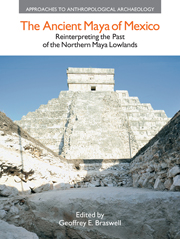Book contents
- Frontmatter
- Dedication
- Contents
- Contributors
- List of Figures
- List of Tables
- 1 The Ancient Maya of Mexico: Reinterpreting the Past of the Northern Maya Lowlands
- Part I THE PRECLASSIC PERIOD
- Part II THE EARLY AND LATE CLASSIC PERIODS
- Part III THE TERMINAL CLASSIC AND EARLY POSTCLASSIC PERIODS
- Part IV THE LATE POSTCLASSIC TO HISTORICAL PERIODS
- 11 Rain and Fertility Rituals in Postclassic Yucatan Featuring Chaak and Chak Chel
- 12 Poor Mayapan
- 13 Maya Collapse or Resilience? Lessons from the Spanish Conquest and the Caste War of Yucatan
- Part V CONCLUSIONS
- Index
12 - Poor Mayapan
from Part IV - THE LATE POSTCLASSIC TO HISTORICAL PERIODS
- Frontmatter
- Dedication
- Contents
- Contributors
- List of Figures
- List of Tables
- 1 The Ancient Maya of Mexico: Reinterpreting the Past of the Northern Maya Lowlands
- Part I THE PRECLASSIC PERIOD
- Part II THE EARLY AND LATE CLASSIC PERIODS
- Part III THE TERMINAL CLASSIC AND EARLY POSTCLASSIC PERIODS
- Part IV THE LATE POSTCLASSIC TO HISTORICAL PERIODS
- 11 Rain and Fertility Rituals in Postclassic Yucatan Featuring Chaak and Chak Chel
- 12 Poor Mayapan
- 13 Maya Collapse or Resilience? Lessons from the Spanish Conquest and the Caste War of Yucatan
- Part V CONCLUSIONS
- Index
Summary
Abstract
The material culture of Mayapan (ca. A.D. 1250–1400), the last great capital city of the northern Maya lowlands, has often been described as “decadent.” Such descriptions, however, are highly subjective. In this chapter, we consider poverty and wealth at Mayapan from a perspective based in modern economics. We find that, as in modern societies, wealth (as measured by house size) at Mayapan fits a Pareto distribution. Nevertheless, compared to two Classic-period sites in Mexico—Palenque and Sayil—the distribution of wealth was more equal at Mayapan, suggesting that economic inequality was less extreme at the Postclassic city. One cause for the decadent material culture of Mayapan, therefore, was that the city was impoverished when compared to its Classic predecessors.
In this essay we analyze the magnitude and distribution of wealth at Mayapan and explore the implications of our findings for the general interpretation of the economy, society, and culture of that city. Mayapan, Yucatan, Mexico, is the largest and most important Maya archaeological site dating to the Late Postclassic period, and therefore inspires a lot of curiosity among archaeologists. Their interest is piqued because, founded by the legendary Kukulcan, Mayapan was the political capital of the largest and most powerful Maya state of its period. Because of its size and power, Mayapan also served as the social and cultural capital of the northern lowlands at the same time. Because it was a late prehistoric site, Mayapan was discussed in many historical chronicles from the early colonial period, and so we possess unusually detailed information about it.
- Type
- Chapter
- Information
- The Ancient Maya of MexicoReinterpreting the Past of the Northern Maya Lowlands, pp. 306 - 324Publisher: Acumen PublishingPrint publication year: 2012



